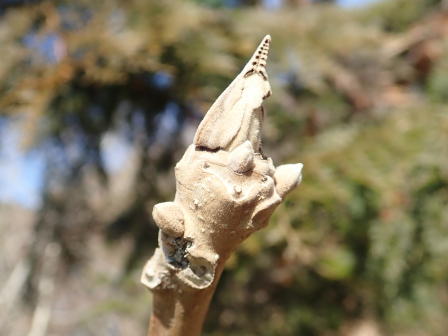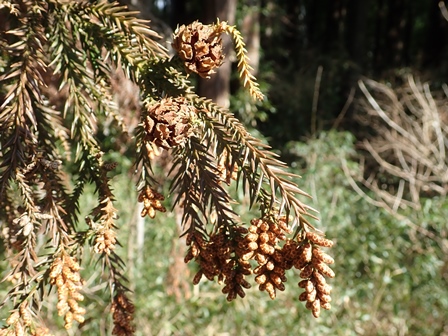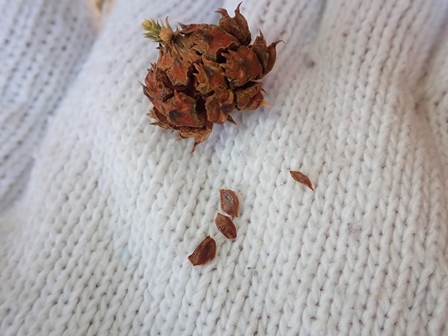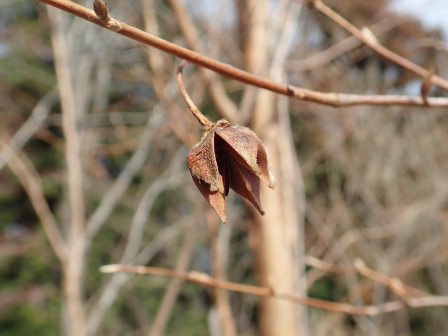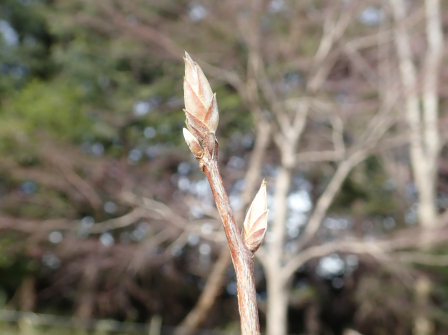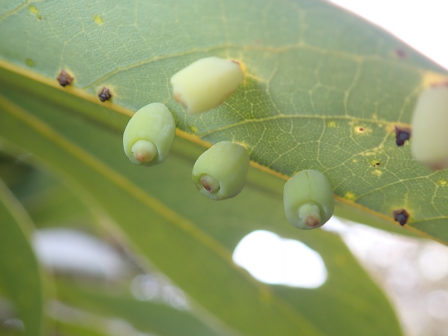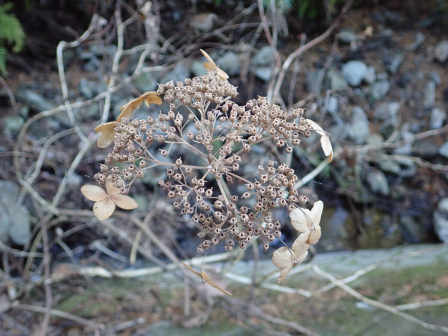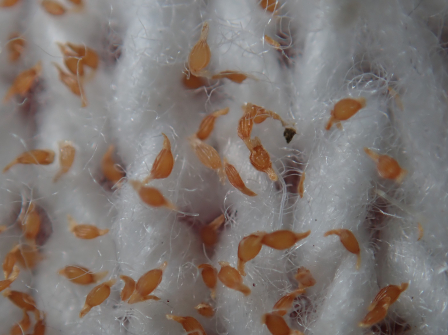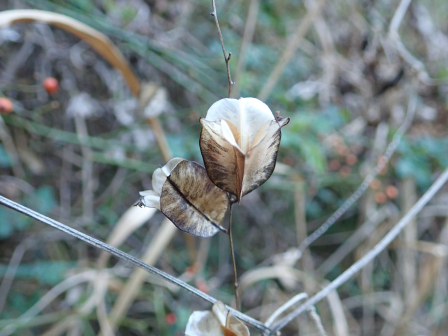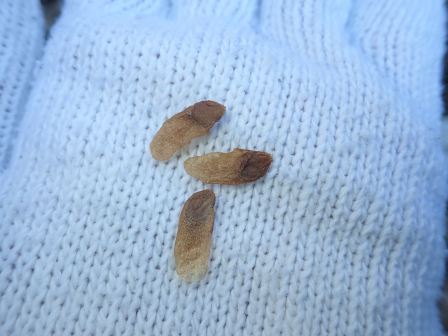フィールド日記
2022年02月
2022.02.25
オニグルミ
写真は共生の森に植栽されたオニグルミの冬芽です。冬芽は裸芽で、短い毛が密生しています。葉痕(葉が落ちた痕)はT字型で、ヒツジやサルの顔のようにも見えます。
The photo shows the winter buds of an "Oni-Gurumi (オニグルミ)" tree planted in the Kyoseinomori-Forest (共生の森). The buds categorized as "naked buds" are densely covered with short hair. Their leaf scar is T-shaped and looks like a sheep or monkey face.
2022.02.22
スギ
写真は駐車場近くのスギの雄花と球果です。雄花はまだ開いていないようで、花粉は出ていませんでした。ニュースによると、東海や関東では暖かくなる今週末にかけて花粉の飛散がピークにはいるようです。
球果は昨年に熟したもので、中には種子が入っていました。
The first photo shows the male flowers and cones of a Japanese cedar tree near the parking area. The male flowers didn't look to bloom yet, so the pollens hadn't come out. According to the news, in the Tokai region and the Kanto region, it's getting warmer from this weekend and the pollen dispersal is going to its peak.
These corns ripened last fall and I found the seeds inside them. (second photo)
2022.02.18
キッコウハグマ
ヒノキ林の林道でキッコウハグマの果実を見つけました。和名のキッコウは亀甲のことで、葉の形が亀の甲羅の形に似ていることに由来します。キッコウハグマは花が開かずに自家受粉して結実する閉鎖花をつけることで知られています。
I found the fruit of the "Kikkou-Haguma (キッコウハグマ)" plants on the path in the Japanese cypress woodland. "Kikkou" in the name means "turtle shell" and it comes from the fact that the shape of their leaves looks like turtle shells. They are known to produce cleistogamous flowers, which are non-opening self-pollinating flowers.
2022.02.15
ヒメシャラ
共生の森に植栽されているヒメシャラに果実がついていました。冬になっても枝に残るようです。果実は硬く木質です。中には種子が入っています。
下の写真は冬芽です。5~6枚の芽鱗に覆われています。よく似たナツツバキの芽鱗は3~4枚なので、冬芽で見分けることができます。
I found the fruit of "Hime-Shara (ヒメシャラ)" tree planted in the Kyoseinomori-Forest (共生の森). The fruit remains on the branches thoughout the winter. The fruit is hard and woody. There are seeds inside the fruit.
The second photo shows their winter buds. The bud is covered by 5 or 6 bud scales. Their close relative species called "Natsu-Tsubaki (ナツツバキ)" has 3 or 4 bud scales, so you can distinguish between the two species by seeing their winter buds.
2022.02.11
タブノキハウラウスフシ
タブノキにタブノキハウラウスフシが見られました。名前の通り、タブノキの葉の裏面につくられる虫こぶで、中にはタブウスフシタマバエの幼虫が入っています。虫こぶの中で越冬した幼虫は、春に成虫となり、新しい葉に産卵します。
I found the insect galls called "Tabunoki-Haura-Usu-Fushi (タブノキハウラウスフシ)" on the leaves of the "Tabunoki (タブノキ)" tree. The name comes from the shape of the insect galls, reminding us of Japanese 'Usu (ウス)', and the place which the insect galls cling to. ("Haura (ハウラ)" means the back of leaves in Japanese.) The larva of the gall midge called "Tabu-Usu-Fushi-Tamabae (タブウスフシタマバエ)" live there. The larvae stay in the insect galls through the winter and become adults in the spring and lay the eggs on the new leaves.
2022.02.08
イタドリ
写真はイタドリの果実です。イタドリは空き地などにいち早く侵入する先駆植物として、生物基礎の教科書にも紹介されています。果実は翼状に発達した花被片に包まれており、風にのって運ばれます。
The photo shows the fruit of the "Itadori (イタドリ)" plant. In a basic-biology textbook, they are known as a pioneer plant, which is the first species to grow wild on a vacant lot. Their fruit is wrapped with wing-shaped petals, so it is carried on the wind.
2022.02.04
タマアジサイ
冬のタマアジサイの様子です。タマアジサイの花は中心の両性花とそのまわりの装飾花からなります。装飾花は結実していませんが、中心の両性花は結実しています。
果実の中には種子が入っています。タマアジサイの種子はとても細かく、1mmほどしかありません。(タマアジサイの花のようすはこちら)
The first photo shows the "Tama-Ajisai (タマアジサイ)" plant in the winter. Their flowers consist of the bisexual flowers and the ornamental ones that margin the whole flower. The bisexual flowers bear fruit, while the ornamental ones don't.
You can find the seeds inside the fruit. The seeds are very small and about 1mm in length. (Click here to read an article about the flowers of "Tama-Ajisai").
2022.02.01
オニドコロ
オニドコロの果実を見つけました。前回紹介したヤマノイモと似ていますが、地下のイモは食べられません。ヤマノイモの果実は下向きにつくのに対し、オニドコロの果実は上向きにつきます。
また、下の写真のように、種子には片側にのみ翼があります。
I found the fruit of the "Oni-Dokoro (オニドコロ)" plant. They are similar to the "Yamano-Imo (ヤマノイモ)" plants that I posted last time, but the roots of the "Oni-Dkoro" plants are not edible. "Oni-Dokoro" plants bear the fruit upward, while "Yamano-Imo" plants bear the fruit downward.
As you can see in the second photo, the seeds have a wing on one side.
- 1 / 1


